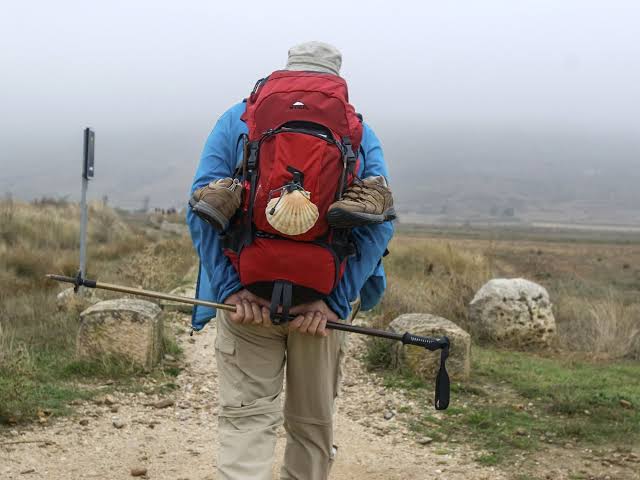This year is on track to beat last year’s record of 446,000 arrivals. But just 10 years ago, only half as many arrived exhausted, exhilarated and with tired feet at their ultimate goal: the shrine of the apostle James in the Santiago Cathedral, whose remains (according to historical sources and oral tradition) were discovered by Bishop Teodomiro of Iria Flavia in the early 9th century. This week, scientists have found that a set of ancient bones, unearthed in northwestern Spain almost 70 years ago, belonged to Teodomiro. And it’s in France, in the Haute-Loire department, that one of the most emblematic routes begins: the Via Podiensis, or the Le Puy Route, which runs from Le Puy-en-Velay to Saint-Jean-Pied-de-Port, in southwest France. Every morning at 7 a.m., from spring to fall, a pilgrim’s mass symbolically kicks off this trek of more than 1,500 km, which can be completed in one go, or broken down into sections year after year — whether or not you’re religious. The journey was first made by Le Puy Bishop Godescalc, who set off around the year 950, escorted by clerics, nobles and armed men charged with warding off the wolves and bandits infesting the countryside. Times have changed, however; today, the journey is safe, the route is perfectly marked and, over the past decade or so, accommodations have evolved. Modern pilgrims Gone are the days when hikers and pilgrims had no other refuge for the night than a dormitory. As demand for services has grown, so too has the diversity of profiles, and specialized travel agencies have sprung up, led by Via Compostela, which offers a full range of accommodation, from gîtes and hotels to charming bed & breakfasts. Sales are growing by 10% every year, and a recent trend is that bookings are increasingly being made in advance. “For the first time, we received requests as early as November, for a week organized for an average value of 800 to 900 euros. It’s becoming impossible to book last minute for a departure in May,” says Laurent Bourdenet, general manager of Via Compostela. “Due to the low number of accommodations, all of which tend to be small, the phenomenon is similar to that of winter sports, a rare vacation that French people plan well in advance.”
A new era The Camino’s popularity has helped to revitalize certain villages, such as Saint-Privat-d’Allier, the first stage of the walk from Le Puy-en-Velay. “As a child, I didn’t like coming to this village on vacation. I found it so grey and full of old people,” says Sébastien, a 55-year-old Frenchman. Today, historic buildings have been restored and turned into gîtes, and the school no longer risks being closed. Shops have reopened, including a bakery, a grocery store, bars and a butcher’s shop run by a Meilleur Ouvrier de France, who makes an excellent dry-cured sausage for the next day’s picnic. “We see backpackers arriving in waves, late morning, early afternoon. In the evening, we can find ourselves chatting with an Australian over a beer at the Kompost’l bar, where good bands play one night a week,” says Françoise Ferreboeuf. The town hall’s secretary for more 30 years, she has witnessed this evolution. “To think that at the beginning, we used to make the few pilgrims sleep in an old school. They were just happy to find a bed.”
This year, hikers can even get a massage in Saint-Privat-d’Allier at the gîte L’Escargot dans sa Coquille, run by Catherine Richard and Philippe Delarivière, who saw the potential of the Camino. Farther along the route, the Refuge du Sauvage in Margeride has become a reference. Managed by a farmers’ cooperative, it serves local produce every evening. A bit farther along, the Fenêtre sur Paysages (Window on Landscapes) program showcases off artists’ creativity; a dozen artistic shelters line the route. The most recent is Suchaillou, a troglodyte shelter suspended from the rock, imagined by leading designer Constance Guisset. Pilgrims can sleep there free of charge by collecting the key from a local whose contact details are on the door. Situated on a windswept pass, the shelter offers a panoramic view of the Chaîne des Puys, volcano chain and UNESCO World Heritage Site. In 2022, the Compostela Pilgrim Ways Agency created a “Commune halte” label for towns and villages that offer a guaranteed welcome and services for all hikers and pilgrims wishing to stop over. More and more communities are applying for the label, including Toulouse, on the Arles route, and Montréal, on the Pyrenean Piedmont route. “We received twice as many applications in 2024, proof that these cities have understood the added value for their region,” says the agency’s president, John Palacin. Paris, the starting point for the Via Turonensis, or Tours route, also joined in late 2023.
An ecosystem “Traveling by foot responds to a need to disconnect from screens, to slow down in a fast-paced world,” says Palacin, who notes that this comes as people are taking a renewed interest in cultural heritage. While the motivations of today’s pilgrims are less and less religious (only 12%), they are not devoid of spirituality, says David Le Breton, sociologist and author of Eloge de la Marche (In Praise of Walking). “A form of spirituality has taken over from religiosity, with the search for an intimate experience, watching the sun rise or a line of ants cross the path. The path has entered contemporary legend, adorned with a certain nobility for having done it.” Little by little, an ecosystem has developed around this pilgrimage. The Miam Miam Dodo (Yum Yum Sleep) guide, created in 1997 and now the guide of reference, sells 60,000 copies a year, up 60 to 70% since its creation. “The idea was born over a cup of coffee, at the request of accommodation providers: There was a shortage of inexpensive accommodation. Pilgrims were knocking on the doors of hoteliers whose rates were too high,” says Jacques Cloutot, the company’s founder. In 2016, Michelin launched its own Green Guide for the Chemin de Compostelle (in French) with a 1/200,000 scale map, a sectional plan showing the entire itinerary, places to visit on each section, and just 220 pages to keep your backpack light. With sales of 50,000, the opus is now in its fourth reissue. “We keep an eye on trends, including the Camino de Santiago, which combines nature, heritage and spirituality,” notes Philippe Orain, director of Michelin Guides. Other players have also come into their own. For the less adventurous, who want to avoid carrying a heavy rucksack, luggage transport companies have emerged, such as La Malle postale, founded in 2009 in Le Puy-en-Velay and now the leader on Le Puy route. “We now hire around 50 people in season,” says co-manager Nadine Ollier, who has observed the emergence of a new profile of hikers: Young couples with children, especially during the Easter vacation, and in July and August. Among France’s top trails With its ever-increasing number of visitors, the Camino de Santiago has become one of France’s top hiking itineraries. At Le Vieux Campeur sporting goods retailer, not far from Rue Saint-Jacques in Paris (part of the Camino) walkers heading for Compostela make up the biggest clientele in the hiking department. “There are more of them than those doing the Tour du Mont-Blanc or the GR20 in Corsica; there’s a wider range of generations, with students, 40-somethings and senior citizens,” observes store manager Louis-Alexandre Lucotte. In terms of popular long-distance walking trails in France, Annie Sissoko, Head of Business Development at the French Hiking Federation, notes a few competitors. “Of course, with all its variants, the Camino is the longest, and its season runs from April to October. But it is still in competition with the Robert Louis Stevenson Trail in the Cevennes, whose numbers doubled recently due to the 2020 film My Donkey, My Lover & I, and the GR20 in Corsica, which embodies the sporting challenge and nature aspect that prevailed 20 years ago.”
Two other trails complete the Top 5: the GR34, which runs along almost the entire coast of the Brittany region, is the most popular year-round path, if you include day trips by locals; and the Tour du Mont-Blanc, which circles the Mont Blanc massif. And while the Camino de Santiago isn’t yet threatened by overtourism, with the influx of tourists on certain sections, others pilgrimage routes could be a better option: the Via Francigena, which runs from Canterbury, England, to Rome; the Tro Breiz (the Tour of Brittany), which links the towns of Brittany’s seven founding saints; the Way of Saint Guilhem, which ends in Saint-Guilhem-le-Désert in the Occitania region; or that of Urbain V, which runs from Aubrac to Avignon. Which will be the next most popular trail? Sociologist Le Breton says the answer is obvious: all it will take is a book or a film, in tune with the aspirations of our times, to indicate the next inspiring trail.


